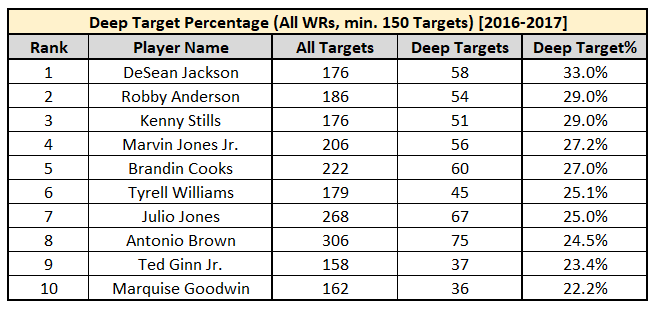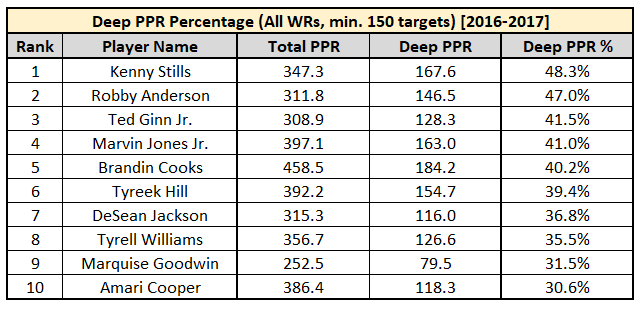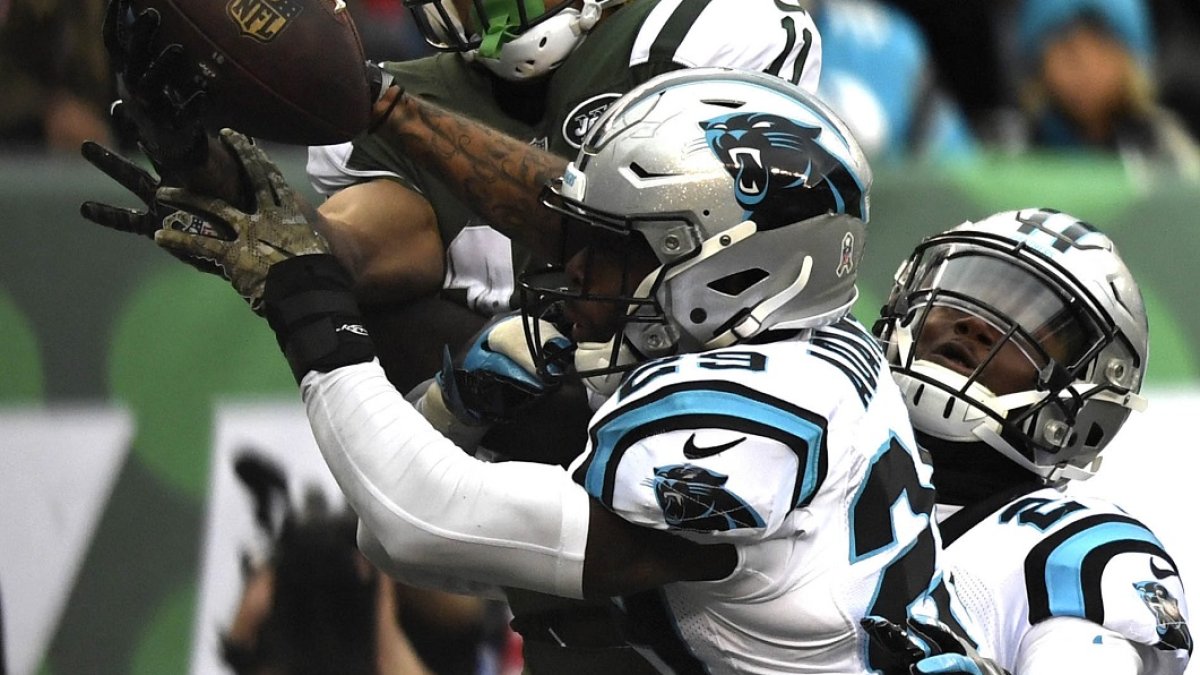(Metrics that Matter is a regular offseason feature that examines some aspect of fantasy through a microscope to dive into the finer details.)
Who was the NFL’s best deep threat last year? That’s a good question I’m asking myself to lay the foundation of this article, but it raises a further question. Who are the league’s deep threats and how do you measure that?
To answer this, I went to our new and revamped Premium Stats page and filtered by “deep passing” for wide receivers. This page looks at all targets a wide receiver drew (in any given season) that were thrown 20 or more yards through the air.
After spending a few minutes with this page, several interesting stats jump out:
- Antonio Brown led in deep targets (43), but only caught 14. That seems atrocious, but the blame likely falls more on Ben Roethlisberger than Brown, considering only 16 of these targets were deemed catchable. Still, Brown totaled only 450 yards and two touchdowns on deep passes, while Tyreek Hill saw 19 fewer deep targets and still totaled 178 more yards and four additional touchdowns. Hill not only led the league in yardage on deep passes (despite ranking 13th in deep targets), he posted the fifth-most deep receiving yards of any receiver this past decade.
- A.J. Green was especially disappointing on deep passes this year, catching only four of 27 deep targets (15 percent), after ranking top-10 in deep receptions and posting a deep-target catch rate of 50 percent or better in back-to-back seasons. He’s someone I’d expect to bounce back in this department next year.
- Robby Anderson saw all seven of his touchdowns come on deep passes, implying he’s far more of a deep-ball specialist than a red-zone threat.
Looking over the past two seasons combined, we can see just how frequently a wide receiver was targeted on deep passes. As a percentage of their total targets, here’s the top-10 list:

The above chart speaks entirely to usage, but tells us very little of production. Looking at each wide receiver’s production (measured by PPR fantasy points) on deep passes compared to their receiving production overall, we can spot which wide receivers were the most heavily reliant on deep passes for their fantasy production. Here’s the top-10 list over the past two seasons:

What does this mean for fantasy?
Wide receivers who are primarily used as deep threats or score a high percentage of their fantasy points on deep balls are typically the more high-variant producers at their position. This means, they’re typically more boom-or-bust than their peers, and it’s harder to predict when those “boom” games are coming. Kenny Stills, for instance, ranked top-30 among wide receivers in fantasy points last season, but he probably didn’t contribute that sort of value to your team, with 44 percent of his total fantasy points coming in just three of his 16 games (and when you likely didn’t start him). Still, a player like Stills would be an ideal late-round gem in a best-ball league, where variance is more your friend.
Digging deeper into these charts, I wanted to point out a few additional player-specific observations I’ve made.
- Over the past two seasons, 33 percent of DeSean Jackson’s targets have come on deep passes (the most in the league), implying he might be far more of a one-trick pony than his peers. Jackson has now finished outside of the top-40 wide receivers in fantasy points per game for the third season in a row. Perhaps Jackson is not the elite speedster he once was and is now too far removed and a good step slower than the 4.35-second 40-yard-dash he ran at the combine 10 years ago.
- Among all 50 wide receivers to see at least 150 targets over the past two seasons, Amari Cooper ranks 32nd in deep-target percentage (17 percent), but 10th in deep fantasy point percentage (31 percent). This leads me to wonder if Cooper is both underrated as a deep threat and overrated as a possession receiver. Cooper leads all receivers in drops over the past three seasons (32) and, over this span, has converted just three of 20 targets inside the 15-yard line into touchdowns, the second-worst rate among all wide receivers with as many attempts. For what’s now the fourth year in a row, I’m skeptical Cooper hits value at his current ADP (WR17).
- Tyreek Hill scored only 71 percent of his fantasy points as a receiver in 2016, which had me skeptical last offseason (prior to Jeremy Maclin’s release), but he has since proved himself as a capable weapon through the air, and especially on deep targets. Not only was Hill the league’s best deep threat last season (by total yards, total fantasy points, yards per target, and passer rating), but he’s also putting up historic efficiency numbers over his short career. His 23.0 yards per target on deep throws ranks best of the PFF-era (2007-present), 21.6 percent more than the next-closest receiver (Brandin Cooks). He specifically helped lift Alex Smith to a new career-high in passer rating. I have Hill as a WR1 in my rankings this year, and am not too concerned with the quarterback change considering Smith’s longer and more pedestrian history as a deep passer and the fact that Patrick Mahomes ranked fifth in deep passing yardage in his final year of college (2016).



 © 2025 PFF - all rights reserved.
© 2025 PFF - all rights reserved.